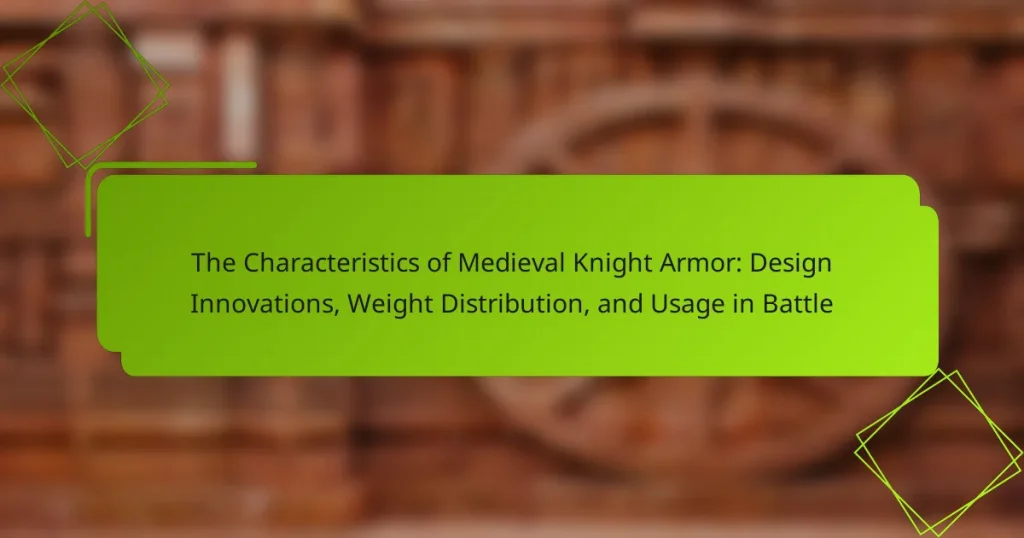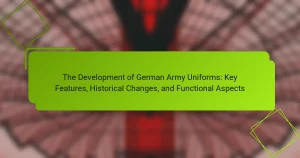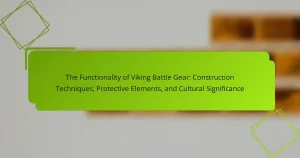Medieval knight armor is a protective gear designed for combat, primarily composed of chainmail and plate armor. Chainmail offers flexibility and defense against slashing attacks, while plate armor, made from steel or iron, provides superior protection against blunt force and piercing weapons. The evolution of armor design, particularly in the 15th century, introduced innovations such as full plate suits that improved mobility and weight distribution. Custom-fitted for each knight, armor featured articulated joints and varied helmet styles, often incorporating heraldry to reflect family lineage and regional identity. The cultural influences on armor design highlight the interplay between functionality and artistic expression, demonstrating how historical advancements shaped battlefield effectiveness and modern protective gear development.
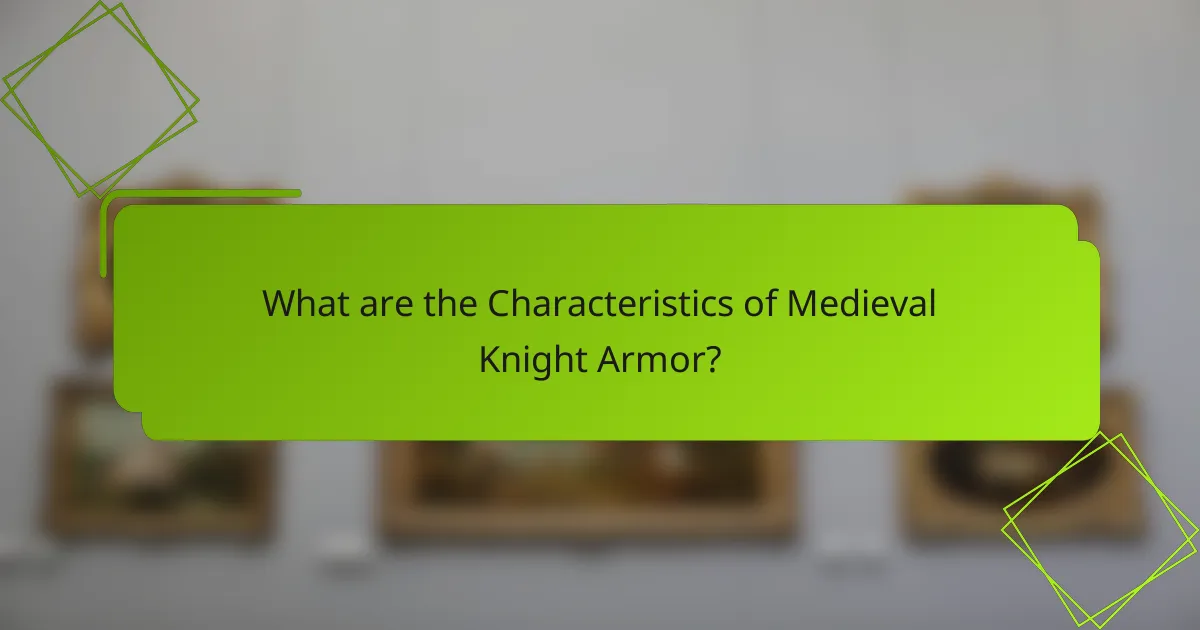
What are the Characteristics of Medieval Knight Armor?
Medieval knight armor is characterized by its protective design, material composition, and functionality in battle. The armor typically included a combination of chainmail and plate armor. Chainmail provided flexibility and protection against slashing attacks. Plate armor, made from steel or iron, offered enhanced defense against blunt force and piercing weapons.
The design of medieval armor evolved over time, incorporating innovations like the full plate suit in the 15th century. This design allowed for better weight distribution, enabling knights to move more freely. The armor often featured articulated joints to enhance mobility.
Additionally, medieval knight armor was custom-fitted for each knight to maximize protection and comfort. Helmets varied in style, often including visors for [censured] protection. The weight of the armor could range from 40 to 100 pounds, depending on the type and period.
Overall, the characteristics of medieval knight armor reflect a balance between protection, mobility, and battlefield effectiveness.
How did design innovations shape medieval knight armor?
Design innovations significantly influenced the development of medieval knight armor. These innovations included advancements in metallurgy and the introduction of new designs such as plate armor. The shift from chainmail to plate armor provided better protection against blunt force and piercing attacks. Innovations like articulated joints allowed for greater mobility while maintaining coverage. The use of specific shapes, like the conical helmet, deflected blows effectively. Additionally, the introduction of lighter materials reduced the overall weight of the armor. Historical evidence shows that these design changes improved a knight’s combat effectiveness. For instance, the transition to full plate armor occurred in the late 14th century, enhancing both defense and mobility in battle.
What materials were commonly used in the construction of knight armor?
Knight armor was commonly constructed using materials such as steel, iron, and leather. Steel was favored for its durability and ability to withstand blows. Iron was often used in earlier armor designs due to its availability and strength. Leather provided flexibility and was used in padding or as a base layer. Chainmail, made from interlinked metal rings, was also prevalent for added protection against slashing attacks. Historical records indicate that these materials combined offered a balance of protection and mobility for knights in battle.
How did armor design evolve throughout the medieval period?
Armor design evolved significantly throughout the medieval period. Early medieval armor consisted primarily of chainmail, which offered flexibility and protection against slashing attacks. By the late 12th century, plate armor began to emerge, enhancing defense against piercing weapons. The transition to full plate armor occurred in the 15th century, providing comprehensive coverage while maintaining mobility.
Design innovations included the introduction of articulated joints, allowing greater movement. The use of different metals, such as steel, improved durability and resistance to damage. Additionally, the incorporation of padding beneath armor helped distribute weight and absorb impact.
As warfare tactics evolved, armor design adapted to counter new weaponry, like crossbows and firearms. The evolution of armor reflected advancements in metallurgy and changes in combat styles throughout the medieval period.
What role did weight distribution play in the effectiveness of knight armor?
Weight distribution significantly influenced the effectiveness of knight armor. Proper weight distribution allowed knights to maintain mobility while being protected. Armor that was well-balanced reduced fatigue during combat. This balance helped knights maneuver effectively on the battlefield. Historical examples show that poorly distributed armor could hinder movement and increase vulnerability. For instance, heavy plate armor concentrated in one area could lead to imbalance and difficulty in movement. Conversely, armor designed with even weight distribution enhanced a knight’s agility and combat effectiveness. This design consideration was crucial for engaging in prolonged battles. Thus, weight distribution played a vital role in maximizing both protection and performance in medieval warfare.
How did armor weight affect a knight’s mobility in battle?
Armor weight significantly affected a knight’s mobility in battle. Heavier armor restricted movement and agility. Knights wearing full plate armor, which could weigh between 45 to 80 pounds, experienced challenges in quick maneuvers. This weight could lead to fatigue during prolonged combat. In contrast, lighter armor allowed for greater speed and flexibility. Historical accounts indicate that knights often chose armor based on their combat style and battlefield role. For example, a knight in lighter armor could adapt more swiftly to changing combat situations. Thus, armor weight was a critical factor influencing a knight’s effectiveness on the battlefield.
What techniques were employed to balance armor weight?
Techniques employed to balance armor weight included strategic distribution of metal and the use of lighter materials. Armor makers designed plates to cover vital areas while minimizing excess weight on limbs. Articulated joints allowed for mobility without compromising protection. Tailoring techniques ensured a snug fit, reducing unnecessary bulk. The use of layered materials provided strength without added weight. Historical records indicate that well-balanced armor improved a knight’s endurance in battle. Adjustments were made based on the specific combat style and individual knight’s needs. These innovations reflect the evolution of armor design during the medieval period.
How was medieval knight armor utilized in battle?
Medieval knight armor was utilized in battle primarily for protection against weapons. The armor covered vital areas of the body, such as the chest, arms, and legs. It was designed to absorb and deflect blows from swords, arrows, and other projectiles. The weight distribution of the armor allowed knights to maintain mobility while being heavily protected. Knights could engage in close combat while remaining shielded from injuries. The design innovations included articulated joints, which facilitated movement. Historical records show that armor effectiveness was crucial in battles like Agincourt in 1415. The use of armor significantly influenced the tactics employed by knights in warfare.
What strategies did knights use while wearing armor in combat?
Knights employed several strategies while wearing armor in combat. They used their heavy armor to absorb and deflect blows from opponents. The design of the armor allowed for limited mobility, so knights often fought in formations. This formation strategy maximized their collective strength and protection. Knights also utilized the weight of their armor to intimidate enemies. The use of cavalry charges was another common tactic, leveraging speed and momentum. Additionally, knights targeted vulnerable areas of their opponents, such as joints in the armor. Historical accounts indicate that these strategies were effective in battles during the medieval period.
How did armor impact the outcomes of medieval battles?
Armor significantly impacted the outcomes of medieval battles by providing protection and influencing tactics. Heavily armored knights could withstand blows from swords and arrows. This protection allowed them to engage more aggressively in combat. The design of armor also affected mobility and stamina. Well-balanced armor enabled soldiers to fight longer without fatigue. Historical battles, such as Agincourt in 1415, demonstrated the effectiveness of armor in defense. The use of armor often determined the success of cavalry charges against infantry. Ultimately, armor shaped battlefield strategies and outcomes by enhancing survivability and combat effectiveness.
What are the key components of knight armor?
The key components of knight armor include the helmet, breastplate, gauntlets, and greaves. The helmet protects the head and often features a visor. The breastplate covers the torso and provides vital protection against blows. Gauntlets shield the hands and allow for dexterity. Greaves protect the lower legs and are often made of metal. Other components may include shoulder plates and backplates for additional coverage. Each piece is designed for both mobility and defense in battle. Historical records show that these components evolved to enhance protection while allowing knights to fight effectively.
What types of armor pieces were essential for a knight?
Essential armor pieces for a knight included the helmet, breastplate, gauntlets, greaves, and chainmail. The helmet protected the head and face during combat. The breastplate shielded the torso from strikes. Gauntlets safeguarded the hands, allowing for weapon handling. Greaves defended the lower legs against attacks. Chainmail provided flexibility and additional protection against cutting blows. Each piece was designed for both defense and mobility, reflecting the needs of knights in battle. Historical records show that these components were standard in knightly armor from the 12th century onward.
How did different armor styles serve various combat scenarios?
Different armor styles served various combat scenarios by providing tailored protection and mobility. Heavy plate armor was effective in frontal assaults, offering maximum defense against swords and projectiles. This style was common in pitched battles where knights faced each other directly. Chainmail armor allowed for greater flexibility and was suitable for skirmishes and fast-moving engagements. It provided decent protection while enabling quick movement. Leather armor was lightweight and favored by infantry, allowing for agility in guerrilla tactics. Each armor type matched specific combat needs, enhancing the effectiveness of soldiers in diverse battlefield situations. Historical records indicate that the choice of armor directly influenced the outcomes of many medieval battles, such as the Battle of Agincourt in 1415, where lighter armor contributed to English mobility and success.
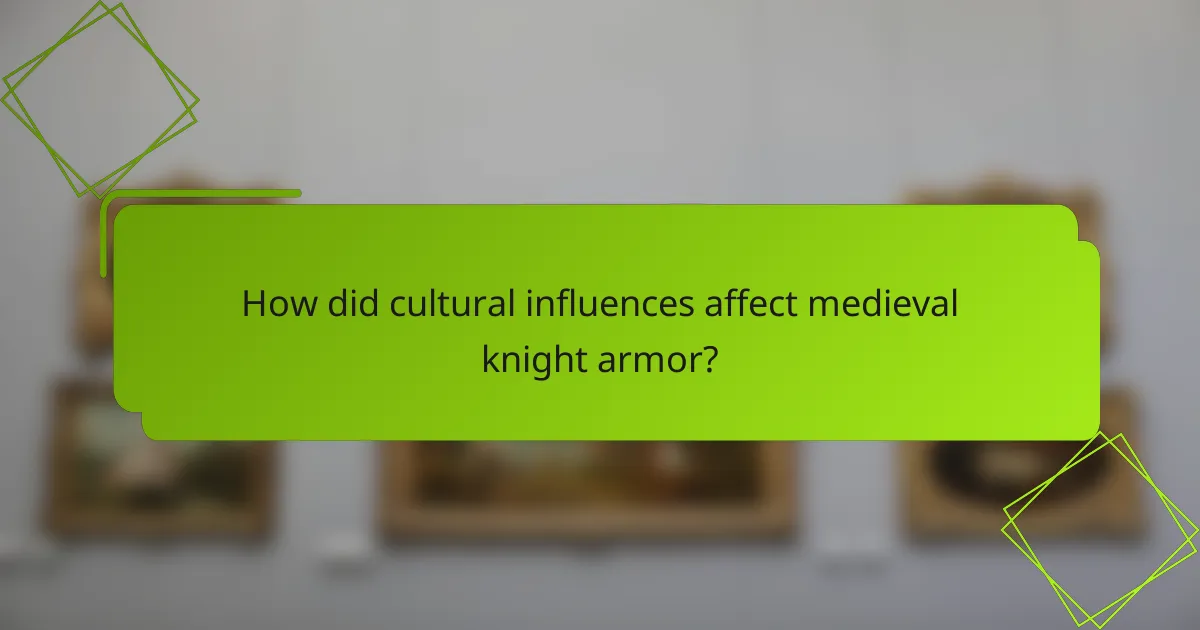
How did cultural influences affect medieval knight armor?
Cultural influences significantly shaped the design and functionality of medieval knight armor. Various regions adopted unique styles based on local customs and warfare needs. For example, the Italian city-states favored ornate designs reflecting Renaissance art, while German armor emphasized practicality and protection.
The use of heraldry in armor showcased family lineage and regional identity, integrating cultural symbolism into the metalwork. Additionally, the rise of chivalric codes influenced armor design, promoting styles that conveyed nobility and honor.
Trade routes facilitated the exchange of ideas and materials, leading to innovations like plate armor, which originated from diverse cultural interactions. Historical records show that armor evolved alongside societal changes, adapting to the needs of knights in different cultural contexts.
What regional variations existed in knight armor design?
Regional variations in knight armor design were influenced by geography, culture, and warfare style. In England, plate armor became popular, characterized by full coverage and articulated joints for mobility. In contrast, German armor featured a more robust design, often with a pronounced tapering at the waist and a distinctive pointed helmet known as the ‘spangenhelm.’ Italian armor was known for its elegance and artistic embellishments, often incorporating fluted designs that enhanced both aesthetics and functionality. Spanish armor, influenced by the Moorish designs, integrated elements like the ‘morion’ helmet and was often heavier, providing substantial protection. Each region’s armor reflected local combat needs, available materials, and cultural preferences, leading to unique adaptations and styles throughout medieval Europe.
How did local materials influence armor construction?
Local materials significantly influenced armor construction by dictating the types of materials available for use. Regions with abundant iron deposits produced heavier, metal-based armors. In contrast, areas with limited resources often relied on leather or fabric for lighter protection. The climate also played a role; colder regions favored layered armor for insulation. Cultural practices influenced design, as local artisans adapted armor styles to reflect regional aesthetics. Historical evidence shows that local materials shaped the effectiveness and functionality of armor in battles. For instance, the use of hardened leather in Mediterranean regions provided flexibility and mobility. Thus, the availability and characteristics of local materials directly impacted the design and effectiveness of armor.
What cultural factors contributed to differences in armor styles?
Cultural factors significantly influenced differences in armor styles. Regional warfare tactics shaped armor design. For example, heavy cavalry in Western Europe required robust plate armor for protection. In contrast, Eastern cultures favored lighter, more mobile armor for agility in combat. Social status also played a role; wealthier knights adorned their armor with intricate designs. Religious beliefs influenced armor symbolism, affecting the materials and motifs used. Additionally, local resources determined available materials, leading to variations in construction techniques. Historical conflicts prompted adaptations to armor for specific threats, like arrows or cavalry charges. These cultural factors collectively created a diverse array of armor styles across different regions.
What innovations in armor technology emerged during the medieval period?
Innovations in armor technology during the medieval period included the development of plate armor, chainmail advancements, and the introduction of articulated joints. Plate armor provided better protection against weapons compared to earlier forms. Chainmail was improved with finer links, increasing flexibility and decreasing weight. Articulated joints allowed for greater mobility while maintaining protection. These innovations were crucial for the effectiveness of knights in battle. Historical records indicate that by the late 14th century, full plate armor became common among European knights, showcasing these technological advancements.
How did the introduction of new weapons influence armor design?
The introduction of new weapons significantly influenced armor design. Advancements in weapon technology necessitated changes in armor to enhance protection. For instance, the introduction of crossbows led to the development of stronger plate armor. This armor was crafted to withstand higher impact forces. Additionally, the emergence of firearms prompted the use of metal plates. These plates were strategically placed to cover vital areas. Historical evidence shows that armor became heavier and more complex in response to these threats. Innovations included articulated joints for better mobility while maintaining protection. Overall, the evolution of weaponry directly shaped the characteristics and construction of medieval knight armor.
What advancements in metallurgy improved armor effectiveness?
Advancements in metallurgy that improved armor effectiveness include the development of steel and the introduction of tempering processes. Steel offered superior strength and durability compared to earlier materials like iron. The creation of high-carbon steel allowed for harder and more resilient armor. Tempering processes enhanced the toughness of steel, reducing brittleness while maintaining hardness. Innovations such as quenching and alloying further refined steel properties. Historical evidence shows that these advancements led to lighter yet more protective armor. For instance, by the late Middle Ages, the use of plate armor became prevalent due to these metallurgical improvements.
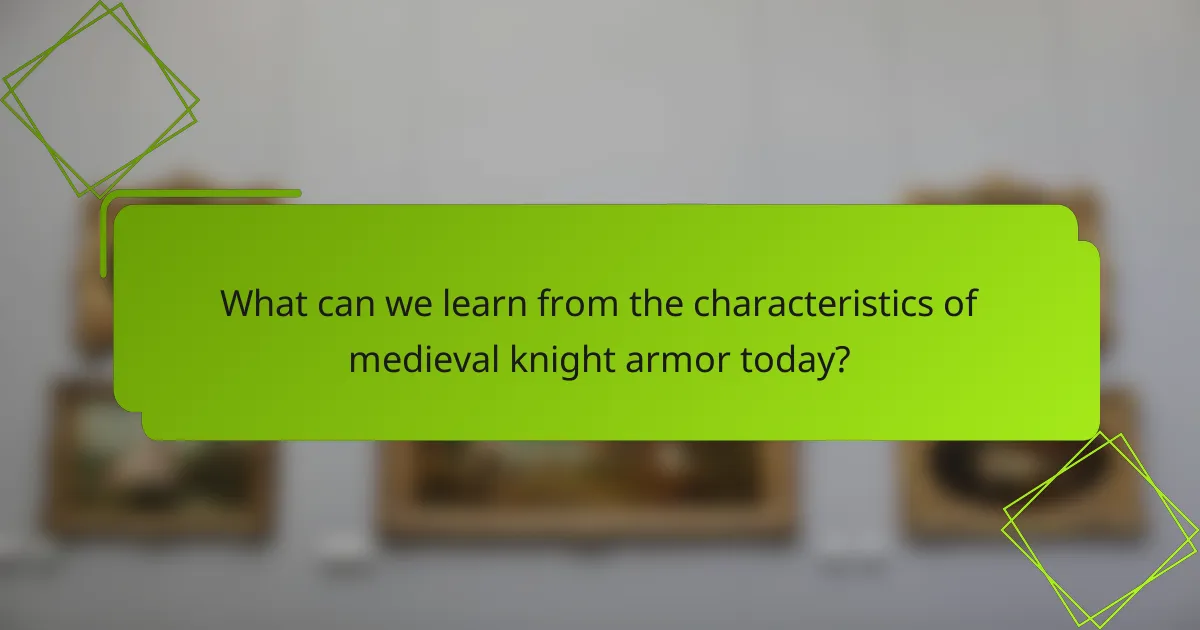
What can we learn from the characteristics of medieval knight armor today?
Medieval knight armor teaches us valuable lessons about design and functionality. The armor’s design innovations reflect advanced engineering for protection and mobility. For example, the articulated joints allowed knights to move freely while being shielded. Weight distribution was crucial; armor was crafted to balance protection with ease of movement. This balance is evident in the use of lighter materials in less critical areas. Furthermore, the layering of materials demonstrated effective strategies for impact resistance. Studying these characteristics informs modern protective gear development, emphasizing both safety and user comfort. Historical evidence shows that effective armor design influenced battlefield outcomes significantly.
How can modern armor designs benefit from historical knight armor characteristics?
Modern armor designs can benefit from historical knight armor characteristics by incorporating their effective weight distribution and protection features. Knight armor was designed to balance mobility and defense. This balance can inform modern designs to enhance user agility while maintaining safety.
The segmented plates of knight armor allowed for flexibility in movement. Modern armor can adopt similar designs to improve comfort and functionality. Historical materials, such as tempered steel, provided durability and strength. Utilizing advanced materials inspired by these can enhance modern armor’s resilience.
Additionally, the layered construction of knight armor offered excellent shock absorption. Modern designs can integrate similar principles to better protect against impacts. The historical focus on coverage can also guide the development of modern armor to ensure comprehensive protection.
In summary, adapting these historical characteristics can lead to more effective and user-friendly modern armor designs.
What lessons about weight distribution can be applied to contemporary armor?
Contemporary armor can benefit from lessons learned about weight distribution in medieval knight armor. Effective weight distribution enhances mobility and comfort for the wearer. Historical armor often distributed weight across the body to reduce fatigue during movement. This principle can be applied to modern designs by utilizing lighter materials and strategic placement of armor components. For instance, placing heavier elements closer to the body’s center of gravity improves balance. Additionally, modern armor can incorporate flexible joints, allowing for greater range of motion. Research indicates that well-distributed weight minimizes strain on the wearer, increasing operational effectiveness. Overall, these lessons from medieval armor can lead to advancements in contemporary protective gear.
How can historical design innovations inform modern protective gear?
Historical design innovations can significantly inform modern protective gear. Medieval knight armor exemplifies effective weight distribution and mobility. The use of layered materials enhanced protection while allowing flexibility. Modern gear can adopt similar layering techniques for improved safety without sacrificing movement. Historical advancements in helmet design, such as visors, can inspire contemporary headgear for better visibility and protection. Additionally, the concept of modular armor, seen in historical contexts, can be applied to modern designs for customization. These innovations demonstrate that lessons from the past can enhance the functionality and effectiveness of today’s protective gear.
What are some best practices for studying medieval knight armor?
To study medieval knight armor effectively, focus on primary sources and historical texts. Analyzing manuscripts, illustrations, and artifacts provides context and details. Visiting museums with armor collections allows for direct observation. Engaging with experts in medieval history enhances understanding. Participating in reenactments offers practical insights into armor usage. Utilizing academic journals and publications ensures access to recent research findings. Collaboration with fellow researchers can foster diverse perspectives. Documenting findings systematically aids in building a comprehensive knowledge base.
How can enthusiasts effectively research historical armor designs?
Enthusiasts can effectively research historical armor designs by utilizing primary and secondary sources. Primary sources include original manuscripts, artifacts, and illustrations from the period. These documents provide direct insights into armor construction and usage. Secondary sources involve academic books, articles, and documentaries that analyze and interpret these primary materials.
Accessing museum collections can also be beneficial. Many museums have online databases showcasing historical armor. Engaging with scholarly databases like JSTOR can yield peer-reviewed articles on armor design. Participating in historical reenactments allows enthusiasts to see and experience armor firsthand. Networking with experts in historical armor through forums or conferences can provide additional knowledge and resources.
These methods ensure a comprehensive understanding of the evolution and context of historical armor designs.
What resources are available for learning about knight armor craftsmanship?
Books on knight armor craftsmanship include “The Complete Guide to Medieval Armor” by Peter Johnson. Online courses are available through platforms like Udemy and Coursera. Museums often offer workshops on armor making. Historical reenactment groups provide hands-on experience. YouTube has tutorials on armor crafting techniques. Academic journals publish research on medieval metallurgy and armor design. Local blacksmithing schools may offer specialized classes in armor fabrication. These resources collectively provide comprehensive learning opportunities in knight armor craftsmanship.
The primary entity of this article is medieval knight armor, which is characterized by its protective design, material composition, and functionality in battle. Key topics covered include the evolution of armor design, innovations in materials and manufacturing, the impact of weight distribution on mobility, and the various styles and components of armor used by knights. The article also explores how cultural influences and advancements in weaponry shaped armor characteristics, alongside lessons that modern designs can learn from historical practices. Overall, the content provides a comprehensive overview of the multifaceted aspects of medieval knight armor.
